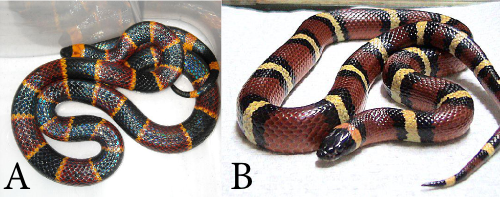The following is a guest post from friend of the blog and Assistant Professor of Biology at Willamette University Chris Smith.

Figure 1. Kingsnakes and milksnakes are Batesian mimics of the deadly coral snake. 1A: An eastern coral snake. Photo by Norman Benton, via Wikimedia Commons. 1B: A Mexican milk snake. Photo by Dawson, via Wikimedia Commons.
Mimicry is a common phenomenon in the natural world, where one organism evolves to resemble another. Familiar examples include (harmless) king snakes that have banding patterns remarkably similar to the (extremely venomous) coral snake (Figure 1), or (palatable) Viceroy butterflies that resemble (toxic) monarchs. These so-called ‘Batesian’ mimics enjoy the benefits of appearing to be dangerous while paying no costs. That is, they escape being eaten by predators without having to produce toxins themselves.
A second, less familiar, form of mimicry is ‘aggressive’ mimicry, in which predators use deception to more effectively attack their prey. For example, some fireflies mimic the sequence of flashes emitted by females of other species, and then attack and eat the unsuspecting male fireflies that come to court them. Similarly, some butterflies in the genus Maculinea are social parasites of ants, and produce chemicals on their exoskeleton that resembles the scent of ant larvae. Foraging ants discover these seemingly helpless babies that appear to have wandered away nest and carry them back to the brood chamber, where the butterfly larvae proceed to devour the ant larvae.
The world of academic publishing has recently seen the convergent evolution of mimicry in ways that remarkably mirror the strategies seen in the natural world. As has been carefully researched and documented by Jeffrey Beall, a reference librarian at the University of Colorado, Denver, the Open-Acces movement has inadvertently given rise to a legion of ‘predatory publishers’. The publishers offer (for a hefty fee) to publish research papers without the process of rigorous peer review that would normally precede the publication of scholarly work. (NIB contributor Sarah Hird described her experience with a predatory publisher here).
Most of the papers published by such ‘predatory publishers’ are Batesian mimics. They enjoy the imprimatur of academic legitimacy without having to pay the cost of rigor, but like the king snake they are otherwise ‘harmless’. These are typically papers of low importance and low impact, sometimes with shoddy experimental designs, that would not pass muster in more rigorous journals. But rarely, if ever, is the work truly fraudulent.
Continue reading →









You must be logged in to post a comment.